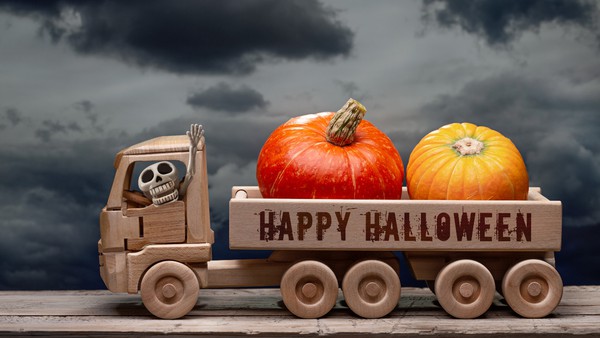Greetings, and happy Samhain—a Celtic tradition that’s aligned with two of California’s favorite holidays: Halloween and Dia de los Muertos. The kickoff to winter, Samhain was the night when ancient Celts believed that the veil between the living and the dead was especially porous. In modern times, it’s the portal to the holiday season, when seasonal spending really kicks into high gear.
A few fun financial facts show that while Halloween can’t compete with “Santa’s big day” for sheer volume of consumer spending, it’s no small potatoes (metaphor chosen to honor the Irish immigrants who brought Halloween to the United States).
• Consolidated Credit reports that 87 percent of Americans plan to celebrate Halloween this year.
• According to the National Retail Federation, “Total Halloween spending is expected to reach a record $12.2 billion, exceeding last year’s record of $10.6 billion.”
• CapitalOne Shopping research tallies show the “average American has a $108.24 budget for Halloween 2023 supplies, such as costumes and candy.”
• The most popular sweet treat in the Golden State? CandyStore.com says that M&Ms are this year’s winner, followed by Reese’s Cups and Skittles.
• The U.S. Census gets into the holiday spirit with a “spooky 16” list of place names, including Casper, Kill Devil Hills, and Slaughter Town.
• WalletHub reports that “57% of Americans say they would consider purchasing a haunted house to live in (but only 18% would pay full market value for it).”
From Rush to Bust
Speaking of haunted houses, here at California Local we’re marking Fright Night with a list of 10 of the most interesting ghost towns in our state, compiled by California Local reporter Graham Womack, an enthusiast of abandoned mining towns, boarded-up stagecoach stops and other relics of the Golden State’s civic history. There’s nothing like contemplating the eerie remnants of Bodie, where 8,000 souls labored to extracted more than $38 million in gold and silver in the late 19th century (more like $85 million in today’s dollars).
Logistics Go Boom
California’s past may have been built on extractive industries such as mining for ore and drilling for oil, but this century many fortunes have been made in the field of logistics. A term taken originally from the military, the industry encompasses all aspects of the “supply chain,” a term that was batted around a lot during the pandemic—when some links in the chain broke down.
In our state, as California Local’s Jonathan Vankin reports, “the ‘trade, transportation and utilities’ sector—which encompasses the core of supply chain logistics—is the second-largest industry in the state, accounting for 14.5 percent of GDP.” In his explainer on how the industry works, Vankin looks at the darker side of this sector of the economy, which enriches many at a great cost to the residents of the Inland Empire and the San Joaquin Valley.
These days we’re all treated to a plethora of products, available at the drop of a mouse. Last-minute Halloween costume? No problem—there’s one-day delivery. But these treats come with a trick for those along the pathways of modern logistics: diesel particulate matter swirling in the air, highways snarled by big rigs, and valuable agricultural land lost beneath sprawling warehouses.
Logistics: the Crucial Industry You’ve Never Heard Of

Logistics is one of the largest industries in California and keeps the state economy running. But it also comes with a heavy cost to the environment. Here are the facts on the most important industry you don't know much about, but should.
Researchers tell LAist that half of California’s population of Sierra Nevada bighorn sheep, which are endangered, died last winter due to record weather. Causes of death include avalanches, starvation and getting eaten by mountain lions after moving to lower elevations for food.
(10/31/2023) LAist
A UCLA climate scientist says California’s redwoods might not last in their current groves for another 100 years. An effort is afoot to plant redwoods elsewhere in more potentially hospitable climates, such as the Pacific Northwest.
(10/31/2023) New York Times
State law requires community colleges to spend at least half their general fund on instructors. But administrators say they want more flexibility to pay for the growing need for student services.
(10/30/2023) CalMatters
Prison Policy Initiative released a new report that delves into the sheer magnitude of criminalization in the U.S., where reliance on incarceration outpaces most of the globe.
(10/27/2023) Davis Vanguard
Forecasters have struggled to understand why tropical storms sometimes blow up into major hurricanes. Scientists have shed some light on this forecasting challenge.
(10/26/2023) YubaNet
Wet weather and planned cuts by California, Arizona and Nevada averted declines that could have threatened water deliveries and power production—but long-term threats to the Colorado River remain.
(10/25/2023) CalMatters
More than 40 states are suing the social media giant. The legal actions allege that Meta has deceived the public about the harms of Facebook and Instagram, which the attorneys general say “exploit and manipulate” children.
(10/24/2023) CapPublicRadio
In partnership with the Marshall Project, Grist publishes an illustrated story about how decades-old decisions to build two California prisons in a dry lakebed left 8,000 incarcerated people at risk when Tulare Lake flooded.
(10/24/2023) Grist
The report, published in the journal Nature Climate Communications, is a warning that one of the worst sea-level rise scenarios scientists have cautioned about since the 1970s is most likely in progress and that little can be done to stop it.
(10/23/2023) → Read the full report







